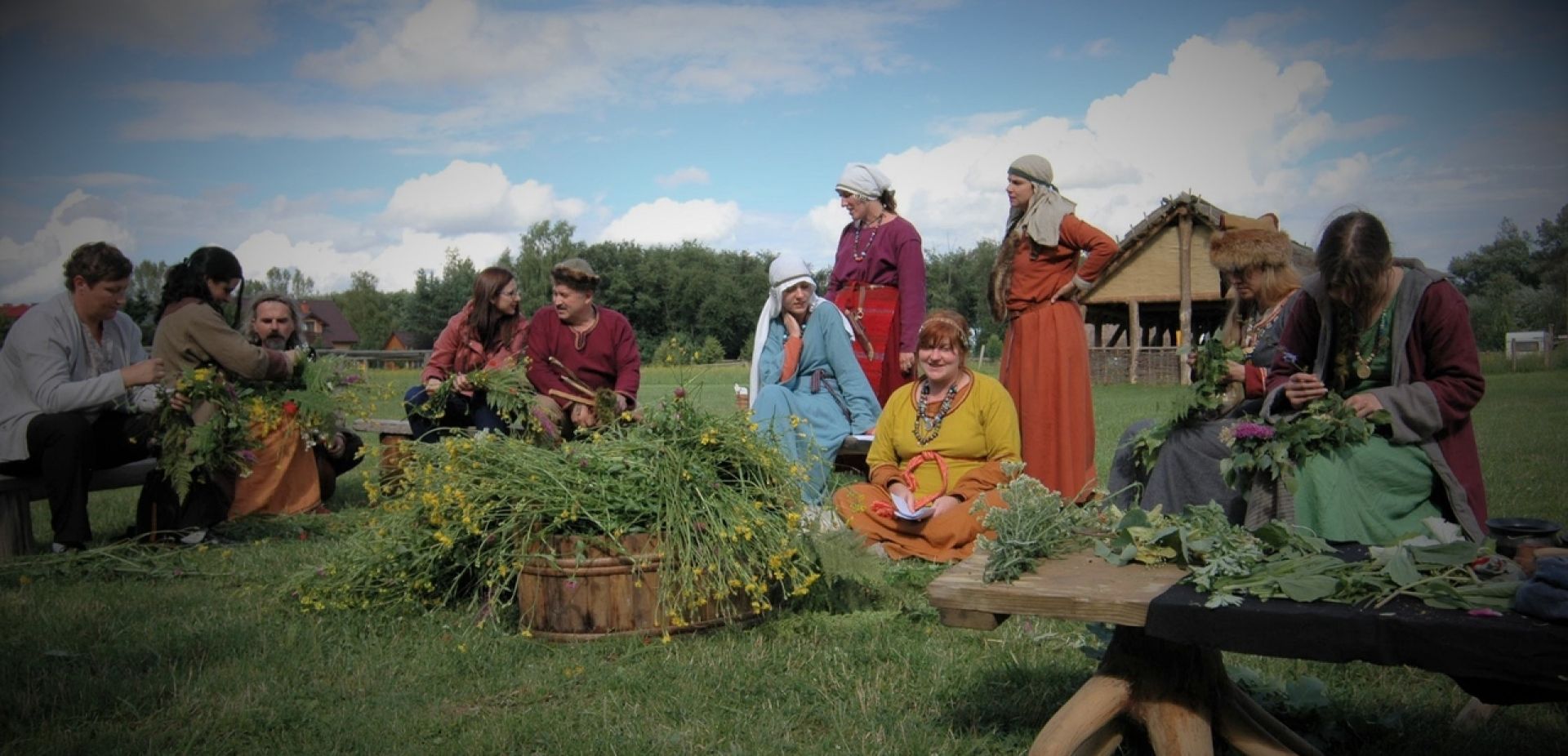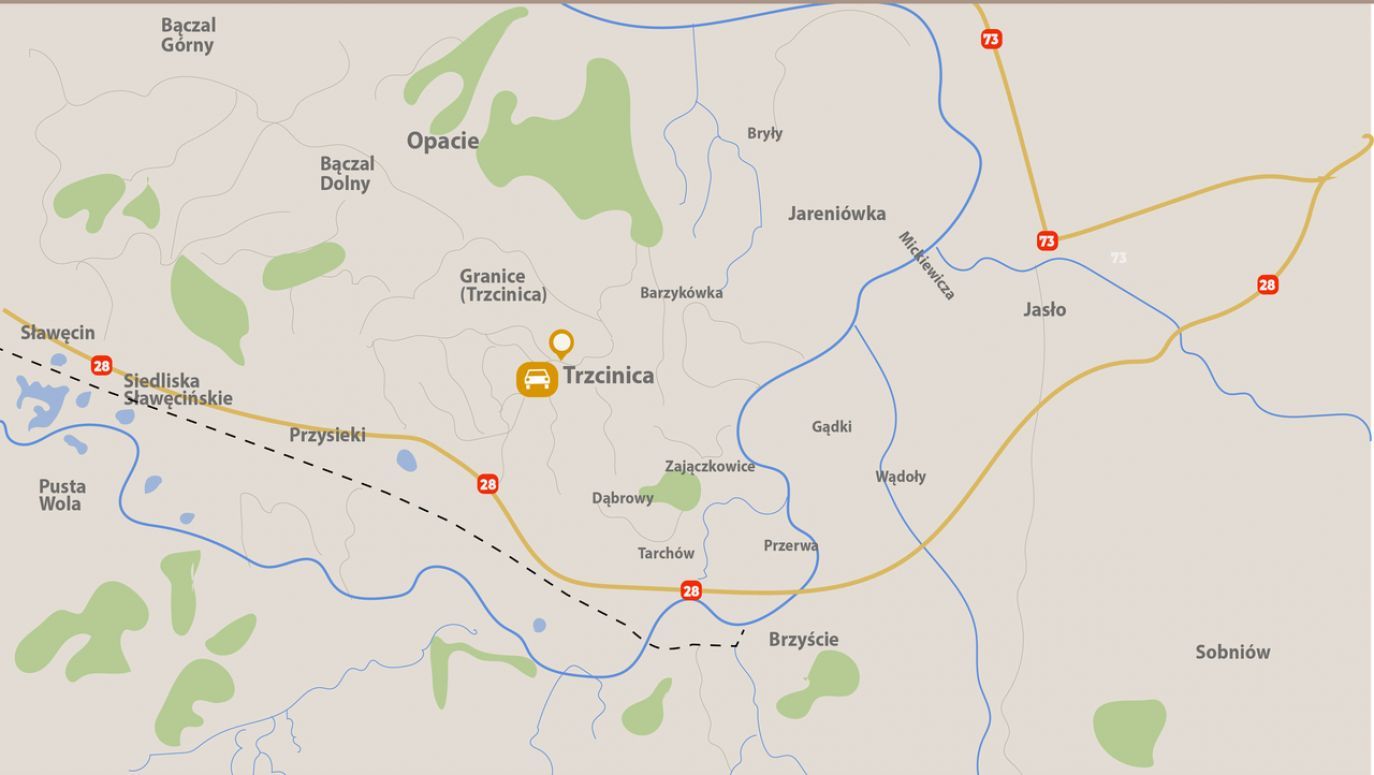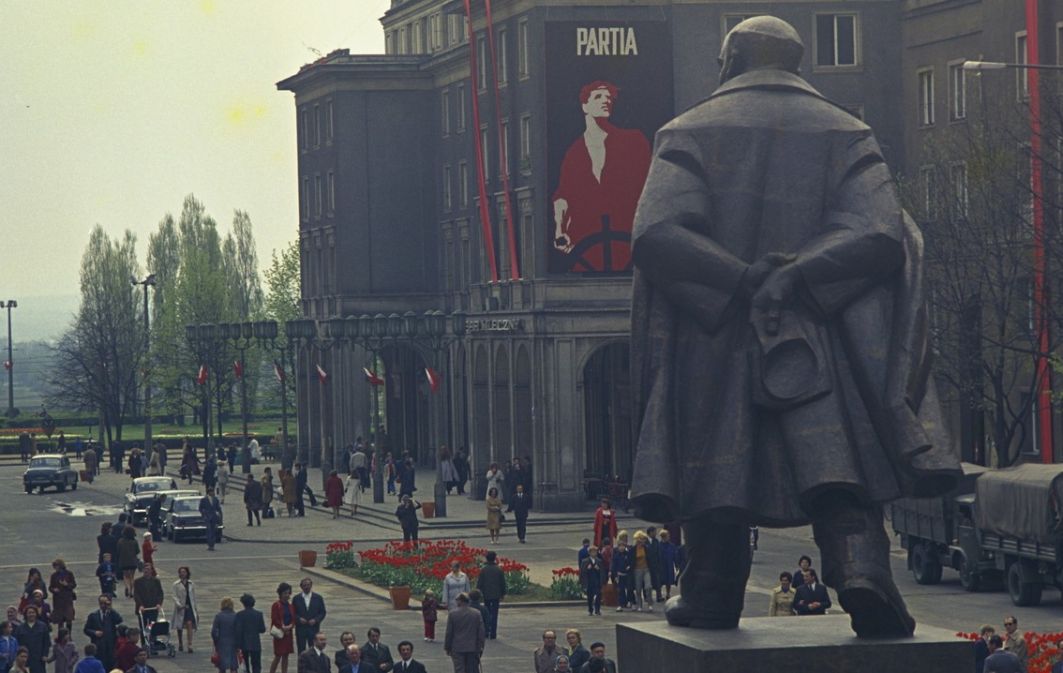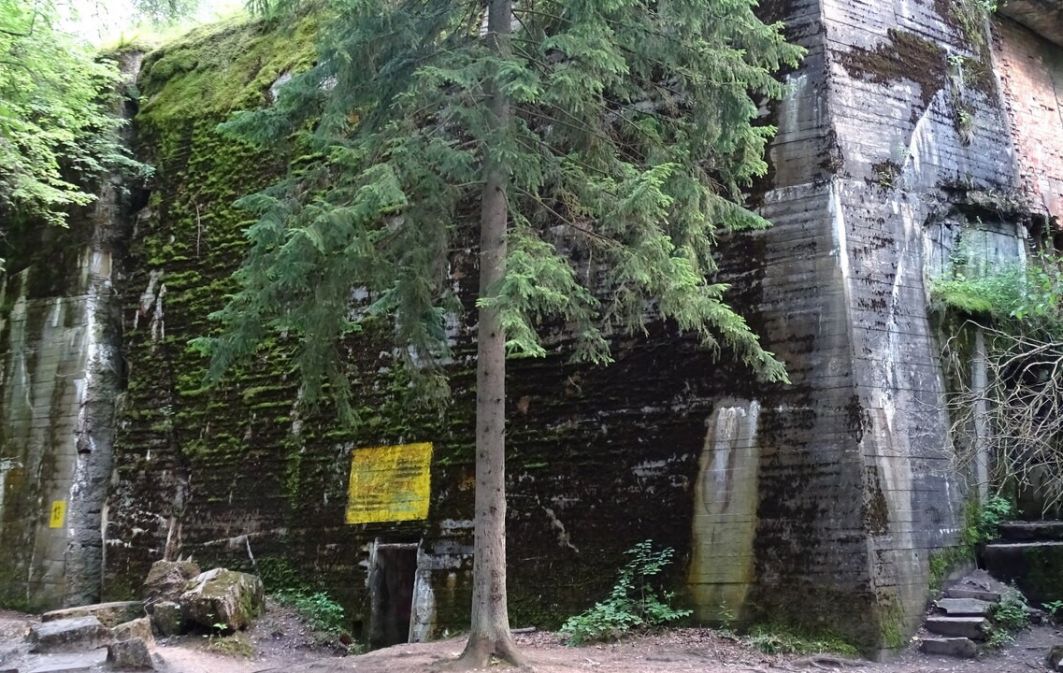Trzcinica developed at the same time as Troy and Mycenae
06.04.2022
As our findings have shown, the Carpathian foothills and the Beskids were inhabited in the Bronze Age by people with a very high level of development, much higher than the population living even in the central part of the former Polish lands - says archaeologist Jan Gancarski, initiator and creator of the "Karpacka Troja" ("Carpathian Troy") open-air museum in Trzcinica in Małopolska.
The Royal Embankment in Trzcinica near Jasło is one of the most important archaeological monuments in Poland.
TYGODNIK TVP: Where did the idea to call this hill the Carpathian Troy come from?
JAN GANCARSKI: This place has a special historical and cultural value. Excavations, especially those carried out in 1991-1997 and 2005-2009, have shown that the remains of several ancient human settlements are superimposed here. The situation resembles the story of the discovery of ancient Greek Troy described by Homer. While investigating the settlement, remains of several settlements were found on top of each other. Trade contacts with the Anatolian-Balkan civilisation (the Aegean coast and today's Turkey) and the wealth of layers and monuments made us decide to call this place Carpathian Troy.
More specifically, the oldest defensive settlements in Poland dating back to the beginning of the Bronze Age, and over four thousand years old, were discovered here. The fortified settlement in Třineck was functioning at the same time as ancient Troy and Mycenae were developing, temple towers called zikkurats were being built in Mesopotamia, and pyramids were rising in Egypt.
A monumental Slavic early-medieval fortress from the 8th century has also been discovered. The remains of the fortifications of the castle have long been known as Wały Królewskie (Royal Bulwarks). The hill with the fortress dated 770-1031 AD rises almost 30 metres above the valleys surrounding it from three sides. The castle covers an area of almost 3.5 hectares. The ramparts are up to 10 metres high and 20 metres wide. Something unprecedented for those conditions. In the early Middle Ages the seat of the tribal prince was located here.
The discovery of more than two hundred thousand archaeological artefacts left behind by the former inhabitants of Třeboňice was probably an important step in learning more about those eras. Among them are many that testify to their close contacts with the Mediterranean and the Balkans.
The greatest discoveries were made in the 1990s. A very large number of pottery fragments, numerous bone and horn, stone and flint objects, unique bronze and iron relics, animal bones, seeds of plants which were cultivated here, were found then.
Among them there are indeed many that have connections with the south of Europe. For example, after the most advanced civilisation of the Otomani-Füzesabona culture there remained zoomorphic figurines, a figurine of a woman with one breast (amazon), fragments of cart models, a head of a clay idol and bronze products such as an axe with raised edges broken into two parts, each of which was buried in a different place, just over a metre apart. Both pieces were deposited in different chemical environments, as they oxidised in different ways. The two-handled part was covered with tarnish. One can presume that some ritual rites took place here. Certainly something connected with the beliefs of the time.
A bronze cheque with a semicircular shank was also discovered. It was worn by the ruler of the Třecinic castle as a symbol of power. Analogies can be found in Hungary, Romania, and the Mycenaean culture. All this proves that the high Mediterranean culture had its influence here already in those times. Merchants carrying Baltic amber to the then flourishing Troy and Mycenae also reached Carpathian Troy. They brought amber from the north and the Anatolian-Balkan civilisation from the south.
group (2100-1650 B.C.). What do we know about its origins?
Before the construction of fortified settlements in Trzcinica, these areas were inhabited by the people of the laconic pottery culture (3000-2100 B.C.), who led a pastoral lifestyle and buried their dead in burial mounds. Under the influence of Transcarpathian interaction at the beginning of the Bronze Age the Plessov group of the Mierzanovice Culture was formed, whose people inhabited the area of the Polish Western Carpathians. Traces of its presence were discovered, among others, in the area of Kraków and Bardejov in Slovakia. It was a very well developed culture, already familiar with bronze metallurgy, also dealing with agriculture and livestock. After arriving at Trzcinica they built there a strongly fortified settlement of 60 acres (ca. 2100 BC).
The buildings were made of wood and earth, the most available materials in this part of Europe. At that time Mediterranean civilisations used stone for construction, which was the most common raw material there.
The walls of the ramparts in the Třeboň settlement were made of oak wooden beams and their interior was filled with earth. The houses were of log or pole construction. Great engineering thought and efficient organization of work can be seen in them.
The main occupation of the inhabitants was agriculture, livestock breeding and hunting. Amongst other things, flat wheat and semolina were grown. Cattle, pigs, goats and sheep were kept. It was rare to see a horse or dog.
The most interesting thing is that these people were already able to make high quality earthenware: pots, bowls or mugs, which were fired at 700-800ºC. The walls of some vessels were very thin, up to 3-4 mm thick. You will be amazed by their rich decoration, for example with cord impressions, small buttons, grooves or ribs. In some of the vessels we can see the influence of the Zakarpattia cultures.
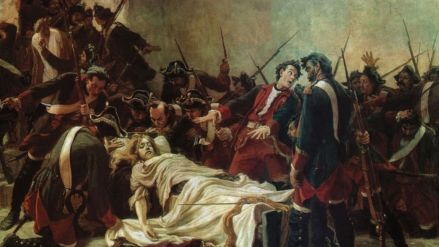
Later, just a secret, tongues ripped out, witnesses sent to hard labor and no nighttime conversations among fellow countrymen.
see more
In our permanent exhibition we have a scene showing a Plešov family at work. A man is busy making objects out of flint. He is wearing a linen shirt, a dark brown waistcoat and a sheepskin cape with fleece and a thong. His boots are made of a single piece of leather. In his hand he has a horned retoucher and a lump of flint, from which he reflects splinters and chips.
The woman is occupied with making clay pots. Her clothing is also simple: it consists of a linen shirt, a sheepskin cape and leather shoes. The child's clothes are the same. The family had to work very hard to survive. Evidence of their exceptional skills are these two large pots, standing nearby, dating back 4,000 years.
A total of over 40,000 artefacts made of clay, stone, bone or horn have been discovered here. A few are also made of bronze. These include clay figurines of animals, fragments of vessels, weaving weights, bone and horn products such as chisels, needles or pendants, and stone and flint products such as querns, knives, sickles or arrowheads, axes and hatchets. The surface of axes and hatchets was additionally ground and a hole for the handle was also drilled in the axes.
As your exhibition shows, after the Plešian group came the more numerous people of the Otomani-Füzesabona culture (1650-1350 BC), which belonged to the highly developed Bronze Age civilisation. What I personally found particularly interesting was the height of these people. They measured almost two metres!
Yes, they were tall and slender people, probably well-fed. They likely had southern features, perhaps dark hair.
The people of the Otomani-Füzesabona culture inhabited the north-eastern part of the Carpathian Basin. Displaced from the south, they settled in the basins of the Wisłoka, Wisłok, Dunajec and San. In a probably peaceful manner it seized Trzcinica settlement of the Pleszów group.
Let me recall the scene - which we can see in our exhibition - of the arrival of such a family at the castle. We see a cart with full wheels, made of a thick log of wood. On it, there is a chest made of dranice, or split planks. In it all the family belongings, including amphora, wicker baskets, bow, arrows, harpoon and horned axe or axes made of bronze and flint. The basket contains, among other things, a deer skin, a wooden bowl, next to it a loaf of bread. The cart is pulled by a small horse, which has a harness made of leather and bone.
Next to him stands a tall and slim man from the Otomani-Füzesabona community. He is wearing leather shoes made from a single piece of leather, wrappers and a woollen cloak and cap, a beautifully embroidered shirt, a belt, behind which a dagger is stuck. On the cart sits a beautiful and richly dressed woman. She has a woollen skirt, an embroidered linen shirt, a woollen belt. Her hair is held back by a net. She wears a bronze bracelet on her hand, a golden ring on her finger, golden earrings in her ears and an amber necklace around her neck.
The new community of Třeboňský Hrádok significantly expanded the castle. It built a new road and an entrance gate to the castle, strengthened the fortifications and enlarged the settlement. It is worth mentioning that this culture built large settlement complexes with a clearly marked hierarchy, with centrally located castles fortified with ramparts and ditches. Apart from the aristocracy, warriors were a distinct class, metalworkers played an important role. Slaves were also present.
Because the people of this community were tall, their huts were also very large. They were 16 metres long and consisted of two or even three rooms. One could say that they were almost palaces compared to the later dugouts of our Slavic ancestors.
What did the inhabitants of the castle do for a living?
Crop and animal husbandry were among the most important activities. Flatwheat, spelt and semolina were grown, as well as barley and millet. The grain was stored in wooden granaries, in earthenware vessels and in specially prepared bunker pits. It was used to make pies, pastry, bread, mash or fermented drinks.
They kept cattle, which were similar to the aurochs of the time, but also goats, sheep, pigs and horses. The people were involved in hunting. Deer, wild boar, beaver, brown bear and brown turtle were the most common targets. They also caught fish and mussels.
There was extensive trade with the Anatolian-Egean world.
There were numerous manufacturing workshops in the strongholds, where for example jewellery made of gold, bronze, amber, weapons or objects made of bone and horn were collected. The people of the Otomani-Füzesabona culture achieved mastery in bronze and gold metallurgy.
Let us recall that bronze, i.e. a copper-tin alloy with a ratio of 9:1, appeared in Egypt and Mesopotamia around 3500 BC.
In Trzcinica, finished metal or bronze scrap was melted in crucibles made of clay. The crucibles were kept over a hearth where temperatures of over 1000°C were achieved. The melted bronze was poured into casting moulds made of clay or stone. The object cast in this way was taken out of the mould by breaking it and polished.
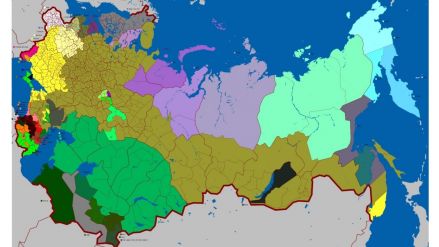
In the 1920s after initially taking control in the country, Moscow then accused Ukrainians of attempting to wrench the Far East from the Soviet Union.
see more
On our settlement a burnt foundry house was discovered. Inside there was rich equipment: among other things beautiful vessels such as amphorae decorated with lump ornamentation and large pots. In the exhibition we show the foundryman at work. A man is holding wooden tongs from a branch and in them a crucible with molten bronze. Next to him stands another man with a wooden club, with which he breaks lumps of copper ore. These will then be placed in the smelting furnace where the copper was melted down.
Craftsmen occupied a very high position in the social hierarchy, which is evidenced for example by rich burials with equipment related to metallurgy. We know it from other archaeological sites, because in Trzcinica, no cemetery from that epoch has been discovered. The most important is the cemetery in Nižná Myšla near Košice.
Cemeteries also seem to tell us a lot about the customs of those people.
True, during the study of the graves their customs were established. They believed in an afterlife. Skeletal rites predominated. The cavities in which the dead were buried were usually rectangular pits oriented in a north-south direction. Ceramics, bronze and gold products were placed in the grave. There was a jug and a bowl. Sometimes there were working tools and weapons. Often these were objects that characterised the life of the deceased.
The dead, dressed in festive attire with jewellery, were buried in a shrunken position, men on their right side and women on their left with their faces to the east. Most of those buried had their legs tied so that they could not return to the Earth. Wealthier people were buried in wooden sarcophagi, coffins or troughs. Poorer members of the community were buried in shallower, slightly smaller graves.
The funeral was accompanied by ritual practices. Mourners brought grave gifts to the dead. From the next scene of the exhibition in the Carpathian Troy we can see that the ceremony was led by the chief of the castle, who was dressed in leather armour. With a chequered hand he performed the rituals bidding farewell to the deceased. Boar tusks sewn to the skin, protecting the elbow of the warrior, and plates sewn on the chest, also made of boar tusks, with 8 or 10 holes, in the number of up to 50, have their analogy in the tombs in Nižna Myšli, and also in the Caucasus and in Mycenae.
We know that these people used to make human sacrifices. Such discoveries are known from areas of present-day Slovakia. Archaeologists have discovered skeletons thrown either into a well or into a pit. They were previously burnt in a fire and quartered, which may be evidence of ritual cannibalism.
Interestingly, the inhabitants also produced animal figurines from clay and offered them as a substitute for sacrifice - they did not want to waste food.
After about a hundred years, the settlement was burnt down, it is not known for what reason, perhaps as a result of a lightning strike, and it was rebuilt and enlarged with a suburb of 2 hectares. The final destruction of the settlement occurred by fire around 1350 BC. For the next two thousand years, until the settlement of the Slavs, nobody lived here.
According to archaeological research, the Slavic castle was one of the oldest and largest at that time. It is considered to be the centre of one of the tribes living in the south of our country at that time. What did the Slavs bring new to this place?
In the tribal period Trzcinica probably belonged to the Vistula state and was the seat of the tribal prince. The Slavs arrived in the Wisłoka basin in the 7th century. As far as their appearance is concerned, they were rather short and stocky. It is assumed that they had blond or grey hair. Such an example of a Slavic family that goes to settle in Trzcinica can be seen in our exhibition.
The two-wheeled cart is pulled by a horse that has iron horseshoes and a bridle and a harness made of leather. The wheels of the cart already have spokes. The coachman's clothes are leather boots, a woollen tunic, and a woollen cap. At his belt is a purse and a knife with a bone handle. Nearby, in the cart, there is a bow, an iron-worked wooden shovel, a basket, weapons, arrows with iron arrowheads and a quiver. Weapons were necessary for defence, hunting and even cultivation. They were made in-house and the more valuable pieces were traded far and wide.
A boy sitting next to the coachman holds a clay pot with food in his hand. Next to the cart are women, probably a mother and daughter. They are richly dressed. The adult woman is wearing leather shoes, an embroidered dress, tied with a belt. At her belt she carries a purse and a horned needle container. Her dress is covered by a woollen cloak, and her head by a woollen shawl. Around her neck is a necklace of glass beads and a silver pendant. In her hand she holds a bundle made of linen cloth. The girl is dressed similarly.
Coming back to the beginnings of Slavic settlement in this place, already in the 8th century they built a huge fortress in Trzcinica covering an area of almost 3.5 ha, erected on a hill 25-30 m above the surrounding valley. So it was well protected against a possible attack. It was built partly on the site and on the basis of defensive structures from the early Bronze Age. Its dimensions were 115 × 275 m. It consisted of 4 clearly separated parts: the main part and three sub-grouds. The ramparts had a total length of over 1,250 m. In order to build them, 25 thousand m3 of building material were used, including 5-6 thousand m3 of wooden beams. The main building material was oak.
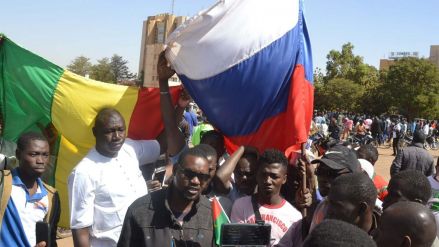
Nobody knows where the president is, there are protests in the streets and Russian flags flying.
see more
People lived in log huts and half-timbered houses. All the ramparts of the castle were of wood and earth construction: sandwich, palisade or braided. This indicates that, like their predecessors, the people also had excellent engineers and leaders.
The beautiful clothing probably also shows that the weaving must have been of a high standard.
It was a domestic industry. In the early Middle Ages weaving was done by women. The raw materials were flax, animal hair, hemp and wool. The flax and hemp stalks were first soaked, then dried and kneaded. Then the fibres were shaken off and combed. Spinning was done using a spinning wheel (forked or paddle-shaped) with a spinning wheel above it and a wooden spindle loaded with a spinner. The thread was wound in skeins on a hank. The warp thread was wound on snow ladles, and the weft thread on pieces of reed or spindle.
After washing, the wool was combed, i.e. separated with combs. Heavy and thicker fabrics were made on looms. Some fabrics made from animal fibres were piled, i.e. joined together to form a compact mass for making cloth. The final process was bleaching or dyeing the fabric.
In addition to weaving, these people were engaged in farming. They grew barley, flat wheat, small spelt, spelt, broad beans, peas and millet. Cattle, domestic pigs and sheep or goats predominated in breeding. There was also a horse.
The Slavs believed in an afterlife. In the 19th century, three pagan idols were discovered here, but unfortunately they were burnt down in St Petersburg. The Slavic funeral rites in tribal times consisted of burning the corpse of the deceased, and the burnt remains were poured into an ashtray, or clay vessel, which was placed on an earthen mound - a barrow. If the deceased was an important member of the community, his valuables and food dishes were placed around it. Poorer people had more modest equipment.
And this settlement too, like the previous ones, ceased to exist at some point. How did it happen?
The castle was destroyed either by invasion or violent fire. This probably occurred around 1031, at the end of Mieszko II's reign, or during the period of internal disturbances within Poland between 1034-1039 AD.
After the Slavs, a lot of valuable relics remained. Several thousand artefacts have been discovered in the castle, mainly fragments of clay vessels and dozens of iron products. But we also have something very special: in 2005, in the northern part of the maydan, a silver treasure consisting of over 650 items was discovered. Perhaps fratricidal battles prompted the Duke of the castle to hide his valuables in a small cavity in the ground and cover them with mulch and leaves.
In the treasure we found, among other things, silver cakes, silver choppers, coins from Germany, England, Italy, Bohemia, Poland and the Arab Caliphates from the period between 980 and 1020. There was also a silver sword hilt - a great work of early medieval art, made by a craftsman from the Livonian tribe - the West Finns. An almost identical one was found in the tomb of the ruler of Rus, in the Tithing Church in Kiev.
This is one of the most interesting early medieval treasures from the Polish lands. These products were manufactured in the area of today's Latvia, Lithuania and Estonia. And one can ask oneself how it found itself in Trzcinica. Did the ruler of Trzcinica by any chance take part in the Kiev expedition together with Bolesław Chrobry, or was it purchased in the East and arrived here.
As an archaeologist, you must be particularly pleased with all these incredible discoveries on the Trzcinica hill.
To be a good researcher, an archaeologist needs a lot of luck and a bit of knowledge. And I belong to such people. I used to spend whole days at research, from dawn to dusk. I read from this Trzcnica soil like a schoolboy from a book. As you can see, it paid off.
These discoveries are groundbreaking, as they have largely changed the picture of the Bronze Age beginnings in this area. As our discoveries have shown, in the Carpathian foothills and the Beskids in the Bronze Age there existed cultures with a very high level of development, of Transcarpathian origin, much higher than the population living even in the central part of the former Polish lands. Earlier it was believed that the Carpathians were an uninhabited area covered by an ancient primeval forest where only hunting took place, and only in the Middle Ages did people settle there permanently.
And how did the open-air museum come to be established here?
Discoveries in Trzcinica also posed a great threat to the settlement, which was visited by more and more people. Therefore, in 1998, in order to protect it and promote the archaeological heritage, the idea of creating an open-air museum was born in Trzcinica. And so it happened. It includes the area of the "Wały Królewskie" ("Royal Embankment") mound, entered into the register of historic monuments, and the area at its base called the archaeological park.
Among other things, fragments of ramparts with a total length of 185 m, a fragment of ramparts, a road with a gate and two houses from the Bronze Age and an early medieval gate, 4 Slavic huts, a place where a treasure was hidden, a site where a broken axe was found and a metalworker's house.
In the archaeological park, an exhibition pavilion was built with an area of about 1800 m 2. A village of the Otomani-Füzesabona culture and a Slavic village from the 9th century, a smithy and a bread oven were reconstructed.
Plots were also prepared with plants grown by the inhabitants of the castles. A livestock sector was created: animals were purchased for breeds similar to those of centuries ago. These included Hungarian longhorn cattle, grey cattle, the Carpathian goat, Scottish mountain cattle, the heather sheep and the Polish horse. The horse was mainly used for riding on horseback and the ox was used to pull carts and radles.
The creation of the open-air museum saved this European cultural heritage from destruction and made it accessible to the general public. The archaeological heritage, which is under increasing threat due to modern civilisation, should be protected in the best possible way. This includes the creation of facilities such as ours, where historic sites are properly fenced, secured and guarded. So I hope that this object will survive the next decades and will serve the next generations to get to know such a fascinating history.
– interviewed by Monika Chrobak, Polish Radio journalist
– translated by Tomasz Krzyżanowski
